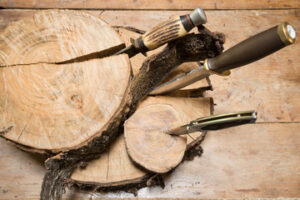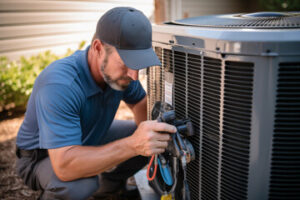When it comes to hunting, having the right knife is crucial. There are several types of hunting knives, each suited to different chores.

The main considerations when choosing a hunting knife are blade design and durability. The ideal knife steel will offer edge retention, toughness and corrosion resistance. For hunters who want to swap out dull blades, replaceable-blade hunting knives are also available. Read on Bugle For Elk for more information.
In the world of hunting knives, there are many different blade designs that each cater to specific needs. Some are better suited for skinning, while others are better for general camp chores or specialised tasks such as gutting and quartering big-game. The blades of hunting knives are also available in a variety of materials. Some are made with hard steels that hold edges for a long time, while others are made with softer metals that have greater flexibility and sharpness.
A good quality hunting knife should have a strong, durable blade that can withstand the rigours of field dressing and breaking down game. It should be well-balanced and have a comfortable grip to ensure that you can keep control of the knife, especially in wet conditions. A non-slip handle will also allow you to maintain a firm hold on the blade when using it for cutting. The blade should be of a size that is convenient for handling, allowing you to cut through tougher skin and bone. Skinning knives with smaller blades are ideal for hunters that want to preserve the hides for taxidermy purposes, as they can make more precise cuts without damaging the hide.
The main choice hunters face when choosing a new hunting knife is whether to go with a fixed-blade or replaceable-blade model. Both have their advantages, but it is important to pick the right type of blade for your needs. Fixed-blade knives tend to be stronger and more reliable than folding blades, but they are bulkier and less portable. A fixed blade is a good choice for those who hunt in rough terrain or with larger game.
Replacement-blade hunting knives are more versatile than their fixed-blade counterparts, and they often come with several different blades. This allows you to switch out the blades as necessary, or to carry an extra blade with you in case one is lost or damaged.
A common blade for a replacement-blade hunting knife is a scalpel blade, which has a fine point and is more flexible than traditional hunting knife blades. However, this blade type doesn’t have the same level of durability as a fixed-blade hunting knife, and it will dull more quickly than other types of blade.
Handle
The handle of a hunting knife is important because it must be sturdy and comfortable to hold. This is especially important when you are using the knife to skin and clean game. A good grip is essential for this purpose, and a hunting knife should have a textured, rubbery surface to help you keep a firm hold on the handle. It should also be able to withstand pressure when you are cutting through bone and hide.
The shape of a knife’s handle is also an important consideration for hunters. A curved or rounded handle is usually more comfortable to hold than a straight or square one. It is also easier to get a grip on when the knife is wet or in cold conditions. The shape of the handle should also fit your hand size. If you have small hands, choose a smaller handle, and vice versa. A finger groove carved into the handle is another useful feature for better handling. This allows you to control the blade more easily and reduces fatigue.
In addition to having a good grip, a hunting knife should have a long and thick blade to cut through bone and skin. It should also be easy to sharpen and durable enough to last through repeated use. Many people use the term “hunting knife” to describe any kind of knife that can be used in the field, but a true hunting knife is designed for specific purposes. Serious hunters will need a variety of different knives to accommodate the size of the game they intend to hunt. However, if you are just starting out, a simple fixed-blade knife will be sufficient.
The blade of a hunting knife can be made from various materials. Stainless steel is common, because it is strong and doesn’t rust easily. However, it is important to remember that it needs to be protected from humidity, which can cause it to corrode quickly. It is recommended that you use a whetstone with a higher grit for proper maintenance of your hunting knife. This will ensure that it stays sharp longer and prevents it from dulling. A good way to test the sharpness of your knife is to use it on a piece of paper. If it cuts smoothly and easily through the paper, it is still very sharp.
Sheath
Many hunters have a variety of different hunting knives in their arsenal. While some are used for multiple purposes, others are specialized for specific types of game. This is especially true for skinning knives. Some of these knives are crafted with a specialized blade shape that is specifically designed to help hunters preserve animal hides for taxidermy mounts. They also feature a quality non-slip handle that allows hunters to maintain control over their cuts.
As any experienced knife hunter knows, a good sheath is as important as the knife itself. The sheath should be made of durable leather, stitched well and be shaped to perfectly fit the knife. It should be secured with a snap or latch and able to withstand the elements. It should also be capable of carrying the knife on a belt or in a pouch, depending on the individual hunter’s preference.
Handles can be fashioned from a number of different materials, including natural and synthetic. While the material isn’t necessarily as important as the design of the handle, it should be comfortable to hold and have a rough texture that provides a solid grip. A non-slip texture is also preferred as this can minimize hand fatigue over prolonged use and provide increased safety in wet or slippery conditions.
The size of the blade is another factor to consider when selecting a hunting knife. Some hunters prefer a small, compact knife that is lightweight and easily maneuverable. Other hunters may choose a larger knife that is heavier and more sturdy. The size of the knife should be tailored to the hunter’s personal preferences and the type of game they will be hunting.
The sheath of a hunting knife is often overlooked, but it’s one of the most crucial aspects of any quality knife. A sheath should be crafted from high-quality materials and can withstand the rigors of field dressing and skinning. It should be able to secure the blade safely and easily, while offering quick access when needed.
Weight
A hunting knife is one of the most important tools a hunter can own. It is used for a variety of tasks on and off the trail, including cleaning game, setting up camp, and even making emergency survival tools. Because of this, hunters want a knife that can be relied upon to perform well under various conditions and situations.
One of the biggest factors that influences the weight of a hunting knife is its blade material. High-quality, stainless steel knives are lightweight and easy to clean. They are also strong enough to cut through bone, skin, and other tough materials. In addition, many hunting knives feature a curved blade shape that is designed for optimal cutting performance.
Another factor that affects the weight of a hunting knife is its handle material. The handle should be comfortable to hold and provide a secure grip during extended use. The handle should also be durable and weatherproof to withstand harsh outdoor environments. Popular handle materials include wood, Micarta, and G-10.
Lastly, the size of a hunting knife is important to consider when selecting a new model. An oversized knife will make it harder to use and increase the risk of injury. To avoid this, it is best to choose a knife that is approximately the same length as your hand. A good way to test a knife’s length is to grab it by the handle and carefully stick your index finger alongside its blade. If the blade is roughly equal to or slightly shorter than your finger, it is the proper size for a hunting knife.
A quality hunting knife is essential to the success of any expedition. Whether you are hiking through the wilderness or stalking an elusive game animal, your knife will be the only tool you can trust to complete the task at hand. So, take the time to research different brands and features to find a hunting knife that is both functional and stylish. Once you have found the perfect knife, be sure to treat it with care and respect so that it can continue to serve you for generations to come.
